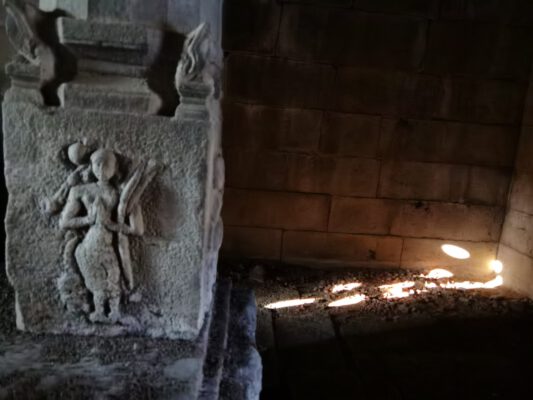MA morning meditation becomes a bit of a routine, although you can hardly say that after just a handful. It is more of a route, a path or an exploration. Like hiking in the mountains: the summit in view is hiking through the trails, on the ridge, through the valleys and rivers, past the rock faces, through scree and rocks, meadows and forests and beyond the vegetation line on the glaciers in the snow, the mountains become a metaphor for the inner search. Climbing a mountain is a spiritual event. Nevertheless, meditation itself can resemble a hike through the mountains, through the valleys of thought, the rivers of life, the memory images on the rocks, the narrow degrees of the logic of thought, the textures of language. The paths of meditation lead past thoughts and memories. And then suddenly, as if lingering in a clearing, the mind stands still, I realize that I am not wandering at all, but I am in silence and concentration, focused on the here and now, on the point that unlocks infinity, right here, from here all these thoughts and images are actually passing by. I am the connoisseur, the observer, I do not exist, the thoughts do not exist, everything is suddenly there in synchronicity, a great view opens up, a view from the mountain top into the world, down to the valleys and up into the sky between the cosmos and the world.
Within the sublimity of this experience, the sublime, which allows me to experience that the cosmos is structured, composed, in change and transformation, but bound by rules, abstract points of reference become visible: geometry, harmony, composition. I think of mathematical constants or functions, of musical harmonies or color theories, of mineral constructions or biological structures. Flowers that form a point of attraction in their colorfulness, geometry, structure, composition, unfolding and smell.
Where do these constants come from? Are they the building blocks of Brahman, from which the world is derived as a process?
Those constants in the cosmos can be found in art. In more traditional theories of art, the search for these laws is the core of aesthetics, divine inspiration, genius, the sublime or the transcendental. The pre-stabilized harmonies are manifested in architectural principles and can be found in sacred buildings, public buildings or private buildings, depending on the function and orientation of the client. Buckminster Fuller used the hexagon from the bee world as a blueprint for social construction. In sacred art, we often find the golden ratio as a reference for harmony; in social space, we find Fibonacci sequences as a model for organic organization. As someone who has studied Western critical theory for decades, this discovery is a revelation.
In an attempt to free myself from the shackles of enlightenment and critical theory, I wandered into postmodernism and learned: music becomes a landscape of emotions, of the soul, of structure, of time consciousness, of anticipation. The image becomes a surface on which the eyes wander, the senses connect, new connections arise and sensations are constituted. The sculpture becomes a counterpart that refers to something that stands in abstract space and is only a placeholder in real space. The juxtaposition of the sculpture in relation to its surroundings creates a dialog that I can enter into. In these aesthetic experiences, I experience the world as a possible, expanded world, enriched by levels of reality, which suggests a different consciousness, that of the artist or other viewers, and allows for dialog, communication, language. Within art there is a reflection of the cosmos. A creativity is kindled here that creates and produces, expresses what has always been there. Connecting with that which has always been there, immersing oneself in an encounter, enables a deep contemplation of central principles of the cosmos as we can experience it. Reading the firmament is a beautiful image for this.
The natural sciences, the hard sciences, find some constants that capture the beauty of the universe - fractals of ice flowers, for example. Some of these constants seem to be central to the architecture of the universe, as if the universe would collapse if you changed a number after the decimal point at pi. At these points, physicists become spiritual. "God does not play dice," said Einstein.








